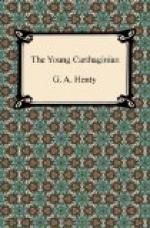As the ship moored alongside the quay Hannibal came on board and warmly embraced his cousin, and then bestowed a cordial greeting upon Malchus.
“Why, cousin Malchus,” he said, “though it is but a year since I was in Carthage, I should scarce have known you, so much have you grown. I see you have entered the cavalry. That is well. You cannot begin too early to accustom yourself to war.”
Then turning, he went among the young men of the guard, to all of whom he was personally known, greeting them with a cordiality and kindness which greatly gratified them. Malchus gazed at him with admiration. Fortunately an accurate description of Hannibal has come down to us. He was one who, even at first sight, won all hearts by his lofty and noble expression, by the kindness and sincerity which his face expressed. The Carthaginians, as a race, were short, but Hannibal was very tall, and his great width of shoulders testified to his immense strength.
The beauty of the Carthaginian race was proverbial, but even among them he was remarkable. His head was well placed on his shoulders; his carriage was upright and commanding; his forehead lofty; his eye, though soft and gentle at ordinary times, was said to be terrible in time of battle. His head was bare. His hair, of a golden brown, was worn long, and encircled by a golden band. His nose was long and straight, forming, with the forehead, a perfect profile. The expression of the mouth was kind but firm. His beard was short. The whole contour of the face was noble in the extreme.
In battle he wore a helmet of bronze closely fitting the head, behind which projected a curved metal plate covering his neck. A band of gold surrounded the helmet; in front were five laurel leaves in steel; at the temples two leaves of the lotus of the same metal. On the crest, rising from an ornament enriched with pearls, was a large plume of feathers, sometimes red and sometimes white. A tuft of white horsehair fell from the plate behind. A coat of mail, made of a triple tissue of chains of gold, covered his body. Above this he wore a shirt of the finest white linen, covered to the waist by a jerkin of leather overlaid with gold plates. A large mantle of purple embroidered with gold hung from his shoulders. He wore sandals and leggings of red morocco leather.
But it was only on special occasions that Hannibal was thus magnificently clad. On the march he dressed generally in a simple blouse like that worn by his soldiers. His arms were borne behind him by an esquire. These consisted of his shield, of Galatian manufacture. Its material was bronze, its shape circular. In the centre was a conical, sharply pointed boss. The face of the shield was ornamented with subjects taken from the history of Carthage in relief. The offensive arms were a sword, a lance, and a bow with arrows. But it was not to the splendour of his appearance that




